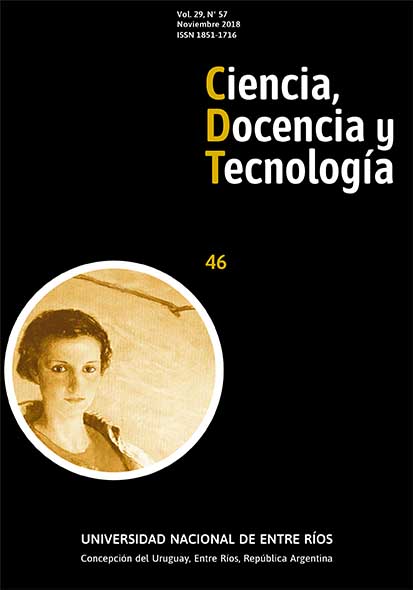Primeros desarrollos de tecnología radar en los principales beligerantes de la II Guerra Mundial. Un análisis desde la perspectiva Ciencia, Tecnología y Sociedad
DOI:
https://doi.org/10.33255/2957/424Palabras clave:
Radar, Historia de la tecnología, Co-creaciónResumen
En el presente trabajo se presenta una historia de la tecnología radar desde una perspectiva socio-técnica. Para ello se analizan los casos de desarrollo simultáneo durante la década de 1930 y hasta finales de la II Guerra Mundial en Alemania, Estados Unidos, Japón, la ex URSS y el Reino Unido. Se recurre al concepto de co-creación a fin de explicar cómo la tecnología y la sociedad se modelaron mutuamente y generaron diversos estilos tecnológicos vinculados al radar. El artículo, basado en fuentes secundarias, realiza un aporte sobre la historia de una tecnología sobre la cual existe escaso material en castellano.
Descargas
Citas
AUSTIN, B. A., (1992). Radar in World War II. The South African Contribution. Engineering Science and Education Journal, 1(3), pp. 121-130.
BEYERCHEN, A., (1994). On strategic goals as perceptual filters: interwar responses to the potential of radar in Germany, the UK and the US. en: O. BLUMTRITT, H. PETZOLD y W. ASPRAY, (eds.). Tracking the radar history. Piscataway, New Jersey: IEEE - Rutgers Center for the History of Electrical Engineering and Deutsches Museum.
BIJKER, W. E., (2006). Why and How Technology matters?. En: GOODIN, R. y TILLY, C. (eds.). Oxford Handbook of Contextual Political Analysis. s.l.:Oxford University Press, pp. 681-702.
BIJKER, W. E., (2013 [1987]). La construcción social de la baquelita: hacia una teoría de la invención. En: THOMAS, H. y BUCH, A. (Coords.). Actos, actores y artefactos. Sociología de la tecnología. Quilmes: Universidad Nacional de Quilmes, pp. 63-100.
BIJKER, W. y PINCH, T., (2013 [1987]). La construcción social de hechos y artefactos: o acerca de cómo la sociología de la ciencia y la sociología de la tecnología pueden beneficiarse mutuamente. En: THOMAS, H. y BUCH, A. (Coords.). Actos, actores y artefactos. Sociología de la Tecnología. Quilmes: Universidad Nacional de Quilmes, pp. 19-62.
BROWN, L., (1999). A radar history of World War II - Technical and military imperatives. Bristol: Institute of Physics Publishing.
CHERNYAK, V. S. e Immoreev, I. Y., (2009). A brief history of radar in the Soviet Union and Russia. IEEE AyE Systems Magazine, Volume Sept 2009 INSERT, pp. B1-B31.
GOEBEL, G., (2013). The Wizard War: WW2 y The Origins Of Radar. [Online]
Disponible en: < www.vectorsite.net/ttwiz.html >
Julio 2013].
GUARNIERI, M. (2010). The early history of radar. IEEE Industrial Electronics Magazine, Sep 2010, 36-38; 42.
JAMES, R. J., 1989. A history of radar. IEE Review, Volume Oct-1989, pp. 343 - 349.
JASANOFF, S., (2004). Ordering knowledge, ordering society. En: JASANOFF, S. (Ed.) States of knowledge. The co-production of science and social order. New York: Routledge, pp. 13-44.
KAISER, W., (1994). The development of electron tubes and of radar technology: the relationship of science and technology. En: O. BLUMTRITT, H. PETZOLD y W. ASPRAY, (eds.). Tracking the History of Radar. Piscataway, New Jersey: IEEE - Rutgers Center for the History of Electrical Engineering and Deutsches Museum.
KERN, U., (1994). Review Concerning the History of German Radar Technology up to 1945. En: O. BLUMTRITT, H. PETZOLD y W. ASPRAY, (eds.). Tracking the History or Radar. Piscataway: IEEE - Rutgers Center for the History of Electrical Engineering and Deutsches Museum, pp. 171-183.
KOSTENKO, A., Nosich, A. I. y Tishchenko, I. A., (2001). Development of the first Soviet three-coordinate L-band pulsed radar in Kharkov before WWII. IEEE Antennas and Propagation Magazine, 43(3), pp. 29-48.
KÜMMRITZ, H., (1994). On the development of radar technologies in Germany up to 1945. En: O. BLUMTRITT, H. PETZOLD y W. ASPRAY, (eds.). Tracking the History or Radar. Piscataway: IEEE - Rutgers Center for the History of Electrical Engineering and Deutsches Museum, pp. 25-46.
QUIROGA, J. M. y Aguiar, D., 2016. Abriendo la “caja negra” del radar. Las políticas de radarización para uso civil y de defensa en Argentina entre 1948 y 2004.. H-Industri@, 10(19), pp. 71-100.
SINNOT, D. H., (2005). Defense Radar Development in Australia: 1939 to the Present. IEEE AyE Systems Magazine, pp. 27-31.
SÜSSKIND, C., (1994). Radar as case study in simultaneous invention. En: O. BLUMTRITT, H. PETZOLD y W. ASPRAY, (eds.). Tracking the History of Radar. Piscataway, New Jersey: IEEE - Rutgers Center for the History of Electrical Engineering and Deutsches Museum.
SWORDS, S. S., (2008). Technical history of the beginnings of radar (History of technology series no. 6). Londres: Institution of Engineering and Technology.
THUMM, M., (2001). Historical German contributions to physics and applications of electromagnetic oscillations and waves. Nizhny Novgorod, Russia, Proc. Int. Conf. on Progress in Nonlinear Science, pp. 623-643.
TOMLIN, D. H., (1988). From searchlights to radar: the history of anti-aircraft and coastal defense development (1917-1953). s.l., s.n.
WILKINSON, R. I., (1946). Short survey on Japanese radar. Electrical Engineering, Volume Aug-Sept 1946, pp. 370-377.
Publicado
Cómo citar
Número
Sección
Licencia
Los autores conservan los derechos de autor y garantizan a la revista el derecho de ser la primera publicación del trabajo, al igual que licenciarlo bajo una Creative Commons Attribution License que permite a otros compartir el trabajo con un reconocimiento de la autoría del trabajo y la publicación inicial en esta revista. Todo el contenido es publicado bajo licencia internacional Creative Commons 4.0: Atribución-No Comercial-Compartir Igual.






